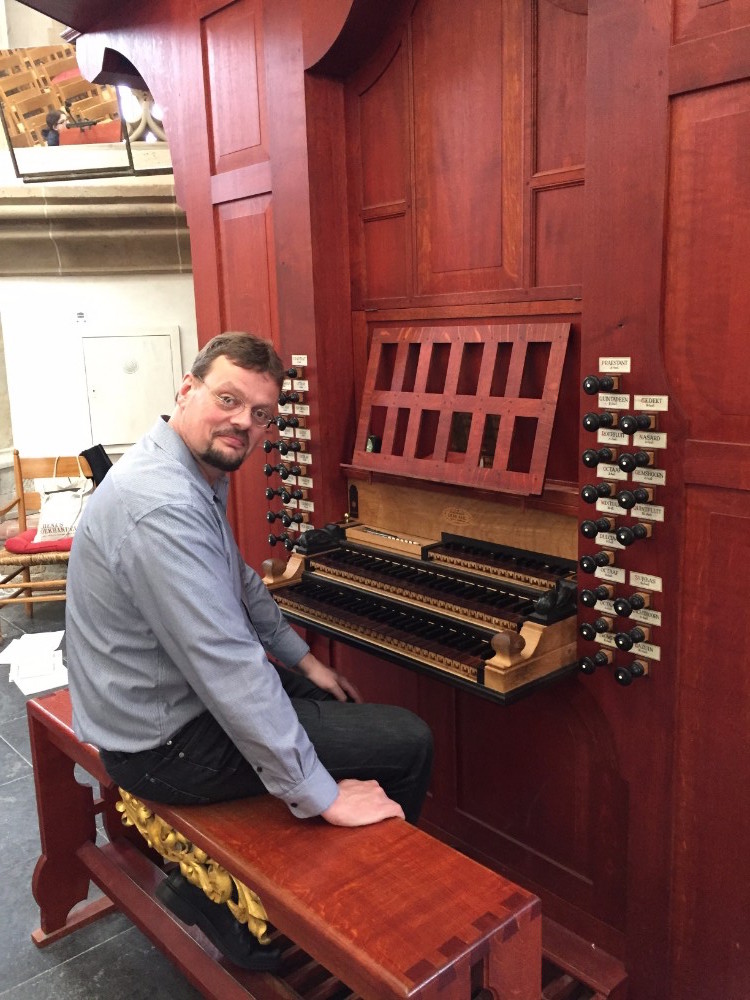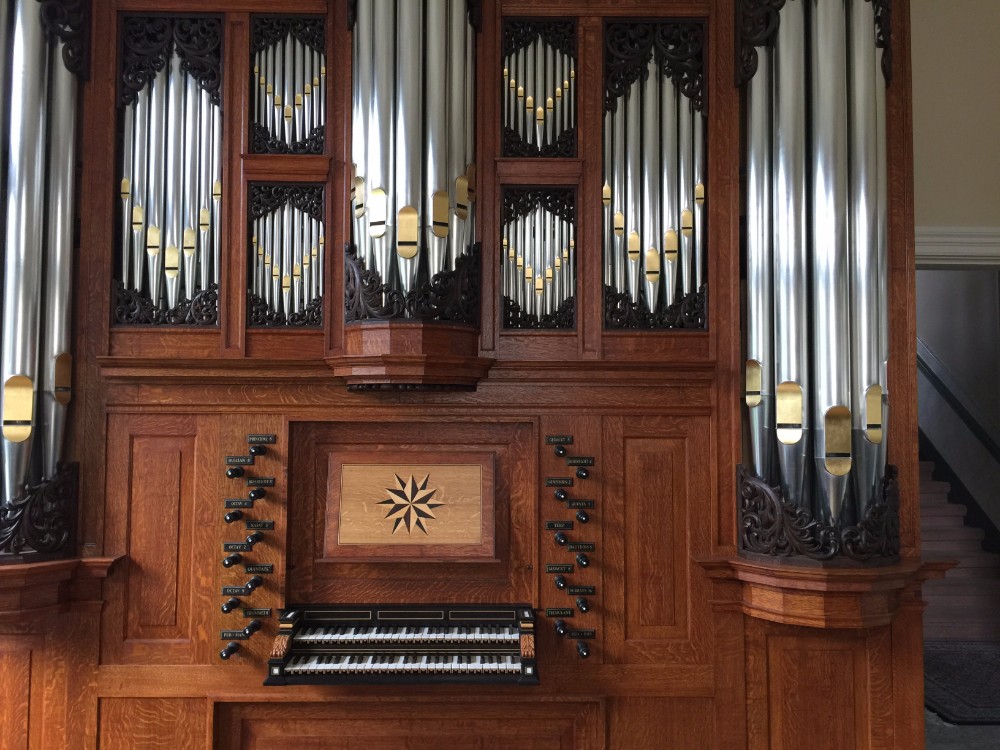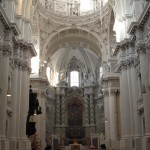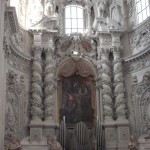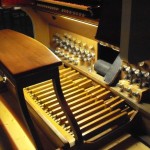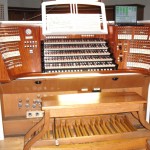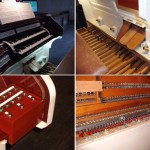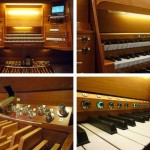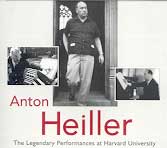
Download the entire Heiller at Harvard CD Booklet (PDF)
Read student reminiscences by George Klump, Franklin E. Perkins, Marian Ruhl Metson, Yuko Hayashi, Stephen Roberts and Christa Rakich
— Text and Photo courtesy David Moran —
The Producers
Josiah Fisk has written about classical music for the Boston Herald, Musical America and the Hudson Review, and is the editor of Composers on Music: Eight Centuries of Writings (Northeastern University Press 1997). He has worked as an organ builder with John Brombaugh and with his father, Charles Fisk.
David Moran has written about classical music for publications ranging from the Boston Globe, Phoenix and Herald to Stereo Review, and has particular interest in Bach keyboard music and Anton Heiller.
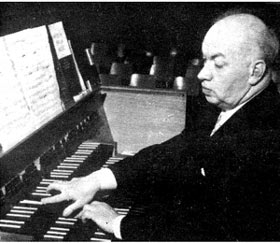 Anton Heiller was born on 15 September 1923, in Vienna, Austria, and died there on 25 March 1979. At the Hochschule für Musik und darstellende Kunst, he studied piano, harpsichord, organ and composition, receiving his diploma in 1942. After the war Heiller taught organ in the school’s Church Music department, and in 1952 took second prize at the famed improvisation contest in Haarlem, Holland.
Anton Heiller was born on 15 September 1923, in Vienna, Austria, and died there on 25 March 1979. At the Hochschule für Musik und darstellende Kunst, he studied piano, harpsichord, organ and composition, receiving his diploma in 1942. After the war Heiller taught organ in the school’s Church Music department, and in 1952 took second prize at the famed improvisation contest in Haarlem, Holland.
Over the following decade, Heiller became highly regarded for his concert performances, especially of Bach. He began making records as well. By the early ’60s, Heiller’s reputation as a teacher drew students from around the world, and he also began occasional touring (photo: at Harvard, 1971). To a remarkable degree, he remained an all-around musician, notably accomplished as harpsichordist and pianist, and esteemed as a conductor. Furthermore, Anton Heiller composed throughout his career, in a rich polyphonic and chromatic idiom — more consonances in conflict and then resolution than the pronounced dissonances of strict serial procedures. Often with a Gregorian flavor, his music keeps company with that of his close friend and mentor Paul Hindemith, along with J.N. David and Frank Martin. One critic has noted that in it there is something reserved: the composing may not have world-shaking ambition, but those ambitions it has it fulfills with a quite satisfying completeness. — DM
Student reminiscences
- GEORGE KLUMP
- FRANKLIN E. PERKINS
- MARIAN RUHL METSON
- YUKO HAYASHI
- STEPHEN ROBERTS
- CHRISTA RAKICH
GEORGE KLUMP
A former music professor and college organist, Klump is a church organist and high-school piano teacher in California.
20th-Century Works | Hindemith | Bach | Bach on this CD set
Chops | Improvisation | Recording and organs
My wife, Barbara, and I were students of Anton Heiller in the early ’60s, the only husband-and-wife team awarded independent grants to study with him.
I first heard him in a festival broadcast in 1955, I think, and marveled at the harpsichord playing, probably in the Fifth Brandenburg. It was announced that Anton Heiller had been the soloist and I decided at that moment that I would study with him if I ever got to Europe. Much was learned from him which we use still today, since it is just as musical now as it was at that time.
We also had him stay in our home when we were living in Dallas and he made only his second trip to the US. An earlier trip, Heiller’s first to the US, was for a very successful recital at the 1962 AGO national convention, in Los Angeles. Heiller was extremely nervous about that concert because he was under the impression that all American organists played from memory, which was not true, although some did. It was true (and remains so) that most European organists use not only music but also an assistant, since the consoles there tend not to be user-friendly.
The organ division where we studied belonged to the Kirchenmusic Abteilung of the Akademie, now called the Hochschule für Musik. It was on Singerstrasse a few blocks below the Cathedral of St. Stephen, on the second floor up over a fish market. There was a small recital hall which held a 2-manual Pirschner, a tracker organ which was extremely difficult to play. Heiller was really the only one who could. He taught all of his lessons on this instrument.
20th-Century Works
As far as Heiller was concerned, any good literature was fair game. Peter Planyavsky was learning the Franck E-major Chorale, and when the time came for the recital, it was Peter who played, plus five others to help. The Pedal was behind the Hauptwerk, essentially, and there were doors on either side of the main organ which could be opened and closed for dynamics. The Ruckpositiv sat a foot behind the organist toward the listener, and it too had doors which opened out. So one student was needed on either side of the organist to work the stops, which were heavy to pull, and a single student out in front of the RP (with score, of course), working the doors on that division. Visually it was an experience, quite beyond the music itself. And four copies of the score were needed to bring it off!Lessons were intriguing. Heiller could come up with some rather complex registrational schemes or changes of manual, or both, as the music might suggest. He was working with my wife once on the Air and Variations by Leo Sowerby, a work he found very interesting and even made quite a point of one time to a visiting composer friend from Denmark. He got so involved with it that he had her play it in a student recital where it stood unique amidst the starker examples of European musical fare. But here again student assistance was required.
He also was quite good with a Prelude and fugue by Olaf Valen that I was working on. The work was actually 12-tone in part but sometimes bitonal as well with two keys clashing simultaneously. He told me that Valen was sort of the grand old man in Norwegian music circles, and what he had done. I wouldn’t say he felt Valen more original than Schoenberg, but he thought him quite able to hold his own in any composer’s company.
Heiller had a technique for communicating accent which he used in everyone’s music regardless of style. In Romantic literature it was, of course, a bit more subtle, but nevertheless it was there. As a Teutonic man he liked to hear contrapuntal lines, or any kind of lines, move, and in that respect treated the French literature in the same way he would treat Bach. It was an anti-Romantic approach, if the sound of the Pirschner was taken into account along with the music. I studied the Franck Pastorale with him and it was most enlightening. Even today I find some of his ideas rather difficult to pull off, but eminently musical if I am able to execute them as suggested. For example, in the French country dance section, Franck introduces triplet sixteenths into the left hand at the outset of each section in the repetition. Heiller showed me a technique for rubato in the right hand but not in the left.
I listened to him teach the Persichetti Sonata for Organ, then quite new, and got some very interesting ideas about registration and contemporary music on the organ. So I taught it to myself later using these ideas. Transferred to an American instrument they came off very well. Heiller had a knack for contemporary music and saw right through it, what it was trying to say, what it was trying to do, and from him I learned much in this area. This is not to say that he was not equally capable with music of other periods; he was!
Hindemith
Heiller’s great mentor was Paul Hindemith. My wife studied the Organ Sonatas 2 and 3 with Heiller precisely because he was so close to Hindemith; their relationship allowed students some insights into Hindemith’s music which were not written in the scores. There was a spot in one of the second movements of one of the sonatas where Hindemith wanted a certain part to be played an octave higher than written in the score. This could be done by actually playing it an octave higher, or using a 4′ stop if that made for better sound. Heiller knew all of these things.Hindemith asked Heiller to premiere his Concerto for Organ and Orchestra with the New York Philharmonic, in 1963; it calls for four manuals. At the time there was only one 4-manual organ in Vienna, at the Austrian Radio Corp., so Heiller used to run over there to work out the setup scheme for the Concerto. Then he left for New York, and we understood the performance was a triumph. Hindemith died a few months later.
Bach
Heiller had very clear ideas about a given work, ideas specific to it. If you would ask him why he did such-and-such to this piece, and then did something in a similar place (you thought it was similar) quite differently in another piece, he would answer that this was a different piece! All attempts to bring a general rule to the music were fruitless. For him each work of Bach was specific.The B-minor Prelude and fugue: the Prelude can be played only on one manual throughout, preferably on a good HW [hauptwerk], piano. Q: Why, since so many players shifted manuals with the change in the number of voices? A: The subtraction and addition of voices will take care of both the dynamic and texture problem, but to change manuals at any of those points destroys the architecture of Bach’s music. One can usually move away from the HW, but it is impossible to return without disrupting the music. True enough, I found. And the fugue? It was designed for three manuals, although it can be just as easily played on two. “Here, I will show you”; and then he did.
The G-major Fantasie, S.572, is in three major sections: a toccata opening, a five-voice motet in the middle which ends on a deceptive cadence, and a final toccata. Each part has a general tempo marking, and these markings are in French. It is the only work Bach wrote this way.
As a student I asked Heiller about it and he told me that, as a general rule, Bach wrote nearly all of his organ music for specific instruments. Either these were organs that were at his regular disposal in his positions or they were organs that he had visited at some point. The latter could be organs which he tested out for churches or instruments he played on his travels. Often they had something special about them, bigger pedal or manual compass or some special manual arrangement, and his music was meant to take advantage of it.
The G-major Fantasie came about as a result of Bach’s travels up the Rhein on the way to Lübeck and later to Hamburg. Many of the organs in the region were French or heavily influenced by French organ building. One need only note Andreas Silbermann as one builder of that persuasion. (Karl Riepp built the Ottobeuren organ very much in this style and that is east of the Rhein even so; some claim it to have the most beautiful organ tone of any in Europe, and the entire manual structure is French to the core.) Silbermann was, I believe, the uncle of Gottfried Silbermann, who later settled in the Upper Saxony area and built many fine organs in and around Dresden. Bach was frequently called upon to test those instruments in a so-called Orgelprobe before the church or other institution accepted the finished product. Bach particularly admired Silbermann’s reeds because, for one thing, they tended to be much more fiery than those of Schnitger and the North German builders. Some of that is probably due to the shallots Silbermann and others like him used, the boat type, which was open with parallel sides and a prow cut on the bottom end. Take a gander at the August American Organist and note the advertisement (p.59) for the Gebruder Oberlinger Orgelbau; it trades on what I have just written.
Now to the music. The opening toccata Bach marks Très vitement. For this piece, the divisional arrangement of organs such as Bach found in the region was more like what Silbermann did, that is, they did not usually have a Rückpositiv positioned behind the organist. A Positiv, yes, but it would be in the main casework, just as with Silbermann. So the spatial relationship of the Oberwerk (or Hauptwerk) and the Rückpositiv did not exist. Therefore, Heiller said, Bach would not write a piece for those instruments that would call for a change of manuals for echo effects not justified by the organ divisions themselves, the organs for which he wrote the music. If the Positiv was up in the main casework, no real spatial effect would exist. So play the opening toccata on only one manual, without any changes, no echo treatment, and be done with it. (I disagreed with Heiller here.)
The second section, the 5-part motet, stands unique in the literature. It must be played on one registration throughout; play it on a good pleno, advised Heiller. The fabric of it does not permit any changes of manual and certainly no change of registration. (I did have a scheme for changing registrations in my younger, more innocent days, but have long since repented of the evil.)
The motet has a famous low B that is a half-step below the traditional pedalboard here and in England (and on the continent, too, nowadays). Q: Didn’t Bach get a little carried away? A: No! He came across this capability in his travels up the Rhein. Many of the larger French instruments of the time had lower pedal notes, as you can see in the music of Marchand, where even low A is written three ledger lines below the bass clef – 1½ steps below the present-day pedalboard! In our discussion Heiller pointed all this out to me: the fact that organs along the Rhein very likely had a pedalboard that went down to BB or even lower, and that Bach took advantage of this when he wrote the movement.
Arthur Poister showed me a good trick on the modern pedalboard to make the listener hear an octave leap down to it – quite ingenious. Otherwise B is simply repeated.
While the opening toccata was to be played on one manual without echo effects, because that was the way those instruments were built, the motet cannot be played on manuals alone. Doing that was suggested in a recentAmerican Organist in an article on the piece, now being called Piece d’orgue because of the tempo markings and in an attempt to show all the French roots of the music. But the motet cannot be played on the harpsichord. In my opinion this is grasping at straws in an effort to make the piece into something deliberately French, which it is not. I cannot imagine Heiller sitting still for too much of this sort of thing.
The counterpoint in the motet is quite beyond anything any French composer, including both Couperin and de Grigny, could ever hope to write. It is German music written by a German composer with a German sound using French elements, including Gravement for the motet. And it hardly sounds like anything any French composer I’ve ever heard about could write. While this is just my opinion, I think Heiller felt very definite about it, too.
The motet ends on a deceptive cadence very possibly so that a registration change can be made, but I don’t know that; in any case the pause is a first-rate example of high drama. The cadence forces the work on to the final toccata, which, I think, is exactly what Bach intended.
The final section is a toccata also better than anything the French could write at the time – harmonically more daring than anything comparable known to me in the French literature. It begins again with fire and is markedLentement. It could be played with echo effects, like the first toccata, but only for a certain distance, and since Heiller said this runs counter to the instruments Bach had in mind, and therefore did not do it, I don’t do it anymore either. And for the same reasons: no spatial effects were possible with everything in a single case a la Silbermann et al. Heiller used a small registration here on one manual to the D pedalpoint at the final cadence, whence he brings on a full pleno with pedal reeds. End of discussion.
The Prelude and fugue in E-flat Major: the Prelude is an obvious reference to the French overture. So the opening is written in abbreviated notation to avoid notational complications. However, it is played in French style. The dotted-eighth and -sixteenth patterns are played opposite to the practice of the day, that is, long slurred to short with the short made still shorter by a break between it and the next long (dotted-eighth). Bach opposed the common French practice here. Why?
Because he wanted to stress the beat and keep the forward motion. The descending sixteenth-note scales are actually to be played as fast sixteenths, almost as 32nds. In this way, one tempo can be used throughout the Prelude and hold it together. Q: Won’t that make the opening sound too fast? A: No; that’s why Bach phrased it long to short and kept it even. The way the suspensions pass the ear in this manner will keep the music from sounding hurried and out of breath.
The Fugue: Three fugues using a variant of the same subject derived from Buxtehude’s E-major Prelude and fugue, I believe. The tempo of the first fugue is broad enough that the whole note of it will equal the dotted half-note of the second fugue, which will equal the dotted quarter-note in the last fugue. In this way the first fugue subject when it appears in the pedal of the third fugue will be in the same tempo as it was in the first fugue.
Bach on this CD set
For the Canonic Variations on Vom Himmel hoch I note Heiller is using the order suggested in the neue Ausgabe rather than the traditional one found in C.F. Peters, that is, having the augmentation canon come after all is said and done. Some of us prefer the order in Peters for musical reasons, but that is a minor thing.At the beginning of my study with him of the Prelude and fugue in C (S.547), he asked me to play it, and heard it out, and then asked with a perfectly straight face if I would like to learn it the right way! I nearly collapsed with laughter inside, but of course said yes, since I was interested in all of his ideas. Actually, his ideas weren’t very far from what I had been doing anyway. He simply detached the pedal motive more between the eighth-note and quarter-note than I did at the time, and advised a few other little technical details which came off well on organs that had an intrinsic intensity and clarity of tone and were well-voiced. He informed me that the architecture of the fugue would not really permit a change of manuals and that the entire fugue should be played through on one plenum registration. My teacher David Craighead and I had worked out a system of moving from a good Great plenum to a slightly lesser plenum on the Positive and Swell divisions at the various sections building to a bigger sound with Positive and Great combined just before the pedal entrance in measure 48. Heiller said no!
What an experience the Partita on Sei gegrüsset was. He taught how to execute one of the variations in French style, which he contended was the way Bach intended, and I would have to agree with him even now. Then the penultimate variation, he said, was a case where Bach wrote deliberately for three manuals, not two, and proceeded to show in the counterpoint of that magnificent variation just how the manuals divided themselves. I must say that this Harvard performance of Sei gegrüsset is ten times more exciting than Heiller’s earlier Swiss recording. It’s a wonder that the men who recorded this got away with it; contracts with management (Lillian Murtagh at the time) forbade such duplication under any circumstances. But lucky for us that they recorded it anyway.
The Prelude and fugue in G (S.541): There were few, if any, Positive divisions worthy of the name in this country; Aeolian-Skinner built only toy Positive divisions, and no one else cared. I note this because Heiller claimed the entire prelude could and should be played on a nice full Positive chorus with a light 16′ reed in the Pedal. And he showed me how to make the accents at the right places and how to play the opening display without accent once you got past the first high G (g”).
The Prelude also contains several places with repeated eighth-notes in the pedal rising scalewise in pairs. The American tendency of the time, and even now, was to play the pitch-change points legato. Not Heiller. Why? I asked. Answer: Bach is changing pitch in the pedal. It is unimportant. Why call attention to it with slurs? (Heiller felt, and I think rightly so, that it was unnecessary from the musical point of view to always call attention to a normal change of pitch by doing something to make it stand out for the listener’s ear. In this regard he and David Craighead stand together. Craighead once called me on this in the B-Major Prelude by Dupré. I phrased a pedal passage which, as an essential musical entity, really wasn’t necessary for the listener to know all about. Craighead called my attention to the fact that, when I broke the line to phrase it, this called undue attention to it and musically it wasn’t all that important and did not need to have attention drawn to it, which is what phrasing it would do. Brilliant! Why didn’t I think of that? So the same for Bach, says Heiller.)
Q: Why are certain manual releases written as quarters and others as eighths? A: Very simple, Bach wanted certain notes to hang on (or cut off) in the atmosphere.
The fugue Heiller felt should be on one manual and played without too much fuss. So he wanted the Great division throughout. The Positive could be coupled after the fermata perhaps with a Pedal 16′ reed added.
About the Passacaglia and fugue in c (S.582) he had some very definite ideas and showed me some comparisons with Pachelbel and Buxtehude. First, he maintained that it was musically (and architecturally) wrong to begin the Passacaglia at piano or pianissimo, as so many still do. He was fully aware that nearly all organists at the time began the work that way, but they were wrong; they hadn’t studied the music. The overall structure of the music would not justify it. Heiller starts it on a fair sound, no pussyfooting around for him; he felt that, structurally, the music had to begin this way, and he proceeded to show me all of the compositional techniques Bach used that could not be done pianissimo considering the number of voices, the texture and all of that. So I learned it with a full beginning on the Great division, when the manuals enter, and where to make manual changes, etc.
This was, he pointed out to me, contrary to the Pachelbel D-minor Chaconne, which, he felt, began and ended softly; but that was different compositional architecture.
The fugue he felt carried right on without dropping time or tempo and he showed me a scheme for making a ritard at the end of the passacaglia to bring the sixteenth-notes into line with the fugue subject which came out of them. And he was quite strong in his view that the fugue was not a double fugue, merely a subject with a countersubject of a rhythmic kind which Bach used to maintain the forward motion after all the passacaglia buildup and to keep a reasonable semblance of texture without too much contrast with what had just gone before.
Chops
As for learning pieces, Heiller could sightread, say, the E-minor Prelude and fugue nearly as well as many could play it. I heard him do it, all the while protesting that he was only sightreading. He owned no harpsichord but was outstanding as a player on it as well. He came into the Vanguard studios to record the Rameau harpsichord works. He’d get there about ten minutes ahead and play through a few things and then record. Have you ever heard the A-minor Air with variations? Unbelievable. He recorded Couperin the same way, and the Handel Sonatas.
It was the same with the organ. If a student was late to a lesson, he might sit down and play until the student arrived. He was to record one of the Haydn Concertos one day, I think it was at the Franziskanerkirche in Vienna. Vanguard had everything set up. Heiller came in and found that the organ was a half-step low in pitch, with middle C sounding as a B. The concerto is in C major and of course it was not possible to do anything with the winds. So without further ado and no extra rehearsal, he played the concerto in C-sharp major (D-flat) so that the orchestra could play it and no money would be lost on the recording session.
About the Epic recording of the Passacaglia and fugue plus the Prelude and fugue in C major on one side and the Variations on Sei gegrüsset on the other: No indication is given about the organ, where it is or what it is, so I wrote him about it. He wrote back and told me all about it and added that this was not a good recording. He was unhappy with the Passacaglia and fugue; it was a little stodgy for him. He had never played some of this literature before. So when he got to the session, he asked to be permitted to run through the Passacaglia and fugue once or twice. He sat there sight-reading it a couple of times and then recorded it. If you didn’t know his real playing, you would think it was first-class. In his later recording of the Passacaglia and fugue, which he did for Vanguard on a Marcussen up in Sweden, the tempo is almost identical, but the performance is light-years ahead of the earlier recording.
He did the same on his second tour. He played the G-minor Fantasie and fugue, among other things. He didn’t want to bring all the music in the original edition and so used Lea Pocket Scores for much of it. His first recitals began with him sightreading much of the program. By the time he got to Dallas, he played the Bach several times and knew it rather well, he thought. The G-minor ended the first half in Caruth Auditorium at SMU (I was turning pages for him, when one could even see the music, that is), and when he finished the Bach, it of itself was so exciting that the entire house came immediately to its feet.
Improvisation
After that, at the end, there were five or six 12-tone but idiomatic themes for Heiller to improvise on. He made a three-movement sonata of them. During the last movement, he brought in the first movement themes against the third movement in the pedal, both straight and then augmented in inversion in the pedal. This was far beyond what anyone had ever heard any French organist ever do, including Cochereau and Marie-Claire Alain; it was remarked to me that this must have been akin to what Bach himself would have done. Needless to say, the audience was overwhelmed at what they had just heard. Heiller never made much out of this ability. I have the original manuscript with the themes and treasure it. That was in October of 1965.Heiller was an admirer of Johann Nepomuk David, and his own compositions for organ tend to reflect this. However, my opinion is that his writing is much tighter and more succinct than David’s.
Recording and organs
About the Marcussen recordings he and Marie-Claire Alain made: they preferred to go to Denmark and Sweden because Zachariessen had developed a very light tracker action that was better than any of the other European builders of that time and Heiller and Marie-Claire preferred this for all sorts of reasons. One of these was the fact that an organo pleno was possible in music which required some tempo. A cardinal principle with Heiller was that, in order for an organ to be good, it must be tracker and have a case. Tone quality came into the picture, too, but it seemed to be almost overridden by the other two criteria, tracker action and a case. That’s why Heiller felt that Flentrop’s finest work was his organ at St. Mark’s Cathedral in Seattle. And he came to America to do it: Heiller was almost saddened that it was not done in Europe – Flentrop in America!
- GEORGE KLUMP
- FRANKLIN E. PERKINS
- MARIAN RUHL METSON
- YUKO HAYASHI
- STEPHEN ROBERTS
- CHRISTA RAKICH
FRANKLIN E. PERKINS
Perkins is a retired professor who taught musicology, hymnology, and organ.I was a student of Heiller at Haarlem in the ’60s, and he also taught me during his summer sessions at Washington University (St. Louis). Naturally, we spent much time on all the Bach literature, the standard stuff. There were so many aspects of playing Bach that he touched on, of course, and most of this information I had already absorbed from other teachers or discovered myself as an organ teacher who constantly was trying to become more informed. Two things in particular I found to be very much along my own line of thinking:
- The importance of relating string playing techniques to the organ keyboard, for example the distinct articulation one achieves through up-bow or down-bow movements. This concept then continued into other articulation devices. I was a string player at one time and related to this idea very much.
- The relationship of vocal music and performance to the melodic articulations, and all the subtleties involved in that medium. Having been a singer also, I related to this concept very well too.
But I wanted to explore other areas with him. My immediate thought was to work on literature from the later 18th century; I had first heard Heiller as a performer providing the organ part in a performance of Haydn’s GreatOrgan Mass in E-flat at the opening concert of the Haarlem sessions of 1964. I thought it would be interesting to work on the extended solo in the Benedictus of the Little Organ Mass in B-flat, also by Haydn. This we did, and in addition worked on the organ parts in the Mozart Church sonatas. I felt that these sessions were giving me a direct link into the performance practices of the Classical period, and I cherish those special insights from the man who was from the Vienna of Haydn and Mozart.
- GEORGE KLUMP
- FRANKLIN E. PERKINS
- MARIAN RUHL METSON
- YUKO HAYASHI
- STEPHEN ROBERTS
- CHRISTA RAKICH
MARIAN RUHL METSON
Ruhl was assistant organist at Memorial Church 1964-’71.
Improvisation | Hindemith on this CD set
I am going to give just a few basic recollections about Heiller’s teaching and also what I learned from him while pulling stops and turning pages for his recitals, which I did at Harvard and in Haarlem. I studied in Vienna from January to June of 1967 and took Heiller’s class as well as Leonhardt and Alain that summer in Haarlem, and in 1970 I returned to Haarlem for another summer course.
The most significant lesson I learned from Heiller, beyond the articulation thing and playing Bach without manual charges, which was a hot new concept in 1967, was how he got one to listen to oneself play every single note on the page and to be aware of how that really sounded. Each note became alive with meaning. You became aware of the touch, the contrapuntal relationships of each line and the structure of the piece. And he wasn’t satisfied until there was an inner rhythmic intensity as well as natural flow to the music.
He taught mostly by example and by singing along while you played. There was a quick discussion of details of articulation, registration and sometimes theological symbolism, and then you were expected to just do it. We rarely spent more than two or three lessons on any piece, which was supposed to be perfect in that amount of time or else you were given a very short lesson. (The better students got longer lessons than the less proficient.)
We were encouraged to come to each other’s lessons; I also pulled stops for Michael Radulescu’s and others’ graduation recitals. I learned a lot of repertoire this way and it all reinforced what I was getting in my own lessons.
The most important thing I learned from pulling stops for Heiller’s own recitals was that he never trusted his ears as to the sound of the organ while seated at the console. One of the lovely jobs of the stop-puller was that you got to sight-read every section of the music that had a different registration, so that Heiller could go into the church to hear the combination from there. I remember this was particularly interesting when it came to his Reger pieces. The only exception to this practice was if he knew the organ extremely well.
Improvisation
One of the most exciting improvisations I heard Heiller do was heard by only one other person, a student from Spain; we were at a church in Holland preparing for a recital that evening. He did not hold the organ in high regard and when he had finished registering all the pieces, he said, “Now what am I going to do about the improvisation on this funny organ?” and he started sort of hitting the keys in jest and laughing and making wonderful faces. Pretty soon the jabbings turned into rhythmic patterns and logical but dissonant chord progressions and he took off for about 10 minutes. We stood there transfixed as the amazing creativity flowed out of this man like a spring of water. When he finished there were great excitement and many compliments, but then a frown came on and he said, “Maybe I used up too much energy this time.” The improvisation that night was similar but not nearly as exciting.
Hindemith on this CD set
On this CD the recording date of the Hindemith is 1973; that must mean the production date, as I remember it did take a while to get done. The recording must have been on Saturday 2 October 1971, after Heiller’s Friday night recital at Brandeis, because that evening was the only logical time there could have been his master class [probably on the Orgelbüchlein]. After a trip out of town he came back to Cambridge to play his Bach recital at Harvard on Thursday 7 October. I have the page numbers of the music on the program I saved – he played all his Bach from the Barenreiter pocket scores. Lenora McCroskey, my successor as assistant organist, and I must have both pulled stops for this as well as for the Hindemith recording session. Heiller always wanted a girl on either side.Heiller arrived at Harvard to give the class and play the recital, and the evening he arrived he had a conversation with John Ferris, University Organist and Choirmaster, and they agreed it would be a good idea to record the Hindemith Sonatas. This had not been previously discussed, to my knowledge. They called David Griesinger, a member of the University Choir and in-house recording engineer, and set it up for the next day.
We started in on Saturday morning at 9 a.m. The procedure went like this: Heiller would work out the registrations for the first movement of the first sonata, write them in carefully; we would rehearse the movement, stopping to do something over only when the stop-puller made a mistake, since Heiller never did. Then we would record that movement straight through, proceeding through each sonata this way. In only a few instances did Heiller do a second take of any section or movement.
I remember someone bringing us sandwiches and we all took seven minutes to chow down, take a john break and then back to work. By 5:30 pm it was done. Heiller was in pretty sad shape – completely exhausted and demoralized, babbling things like “What a terrible recording” and “poor Paul – what would he say?” He gave Griesinger some instructions about splicing a few sections and then he fell apart. Our main concern was to get him revived to do the master class in two hours. Would he ever be able to do it?
We whisked him off to a restaurant in Harvard Square. After the second beer he had changed his tune to “It wasn’t too bad, was it?” After several more beers and dinner, he decided that it really wasn’t bad – in fact maybe it was okay. He started smiling and joking, looking like a completely new man. Soon after, he proceeded to give a brilliant master class complete with insightful commentary on musical and theological meanings as only he could do.
About 10:30 pm a weary John Ferris was ready to escort Heiller to his guest room at Lowell House, but no. Heiller wanted to go to David Griesinger’s and listen to the tapes. A very weary John Ferris escorted Heiller to his room after that was done, about 1 a.m. But Heiller was pleased, and knew Paul would be too.
- GEORGE KLUMP
- FRANKLIN E. PERKINS
- MARIAN RUHL METSON
- YUKO HAYASHI
- STEPHEN ROBERTS
- CHRISTA RAKICH
YUKO HAYASHI
Hayashi joined the New England Conservatory in 1960 and has chaired the organ department since 1971.
The first time I saw Heiller was as a student in Boston; he was on his first American tour and I heard him at the Busch-Reisinger, in 1958. All Bach, from memory; his performance just shocked me. I knew I had to study with this man one day. I took harpsichord lessons with Gustav Leonhardt, commuting to New York every week, and about organ he had said, “You should study with Heiller,” but I said to myself, “Oh well, who’s Heiller?” I bought the old Epic records, but they are not like in person. So when he came to Boston, I did not expect that kind of shock.
In 1965 I found out he was going to be teaching at Washington University, so I took the summer course, six weeks, four hours in the morning, Hindemith, Reger, David and Bach. On a Möller!
In the afternoon he gave private lessons. I remember I played the Wedge, and he listened and said “You are a good musician,” then went on and changed the phrasing, the articulation. Which was upside-down. Upbeat-to-downbeat was how we used to play; Heiller changed it to downbeat-to-up, downbeat-to-up. He made a nice comment, and then a complete turnaround. With Bach it also sounded like he was playing everything staccato, to make it so clear. So at first I scored it that way, putting dots above every note; when he saw, he said, “Oh no, oh no.” He also was doing detailed dynamics before anyone else. But always encouraging; you never got discouraged. After I hear Heiller, I think, Yeah, I can play like that too. Down to earth, an ordinary person, looks and acts like it; willing to be silly. He was so relaxed when he played. Concentrated, intent, but relaxed.
I later invited him to play in Japan, and we visited Kyoto, which is surrounded by mountains; we stayed up in the mountain, in a hotel, and there was snow, a foot, and we took the car and went down all the way to Kyoto. So: Snow, then it changed to rain, and at the bottom the sun was shining. He was ecstatic at this; he said, “This is Bach!”: everything has to be included. We also visited a shrine, a temple, and he loved the moss that covered everything, nicely arranged moss on rocks; he knows nothing about Japan, but he can feel it. I took him to a Noh play as well, and the next day he started to imitate it, very funny, and he really got it. He wanted to go to Mass, so we found a Catholic church. He really let go of himself: his face was so shiny and lifted up and full of peace and joy. Transfigured. That is why he has to go every day. He could be so down to earth, and then something else when he started to play, and then something else again at Mass. His sensitivity was wider than most people; he felt everything.
For a recital in Switzerland once, there was a big crowd, twice what the church could hold, so he sent half of them into town for dinner. He performed, then seated the second crowd, and did it again. Smoked for ten minutes between. At King’s Chapel in Boston, he had just flown in, and complained about how tired he was. [The composer Daniel Pinkham recalled that Heiller came when the organ was new; the plane was very late and he arrived with only minutes to spare; hadn’t seen the organ before, but tried out briefly perhaps 12 registrations, said he was happy, and proceeded to play the recital as if he knew the instrument well and were completely comfortable – DM.] He played for four hours, 8 to midnight; it was dynamite, and just got better and better.
I don’t know, if I did not meet Heiller, where I would be.
- GEORGE KLUMP
- FRANKLIN E. PERKINS
- MARIAN RUHL METSON
- YUKO HAYASHI
- STEPHEN ROBERTS
- CHRISTA RAKICH
STEPHEN ROBERTS
Roberts is music professor at Western Connecticut State University.
Heiller’s Registrations | Ecce lignum crucis | Rhythmic Sense | The Alice Tully Hall Cancellation
I was privileged to study with Heiller in 1973-’74. Fortunately, it was at a time when his health was still relatively good; I recall his missing only a couple of lessons the entire time I was there. The thing that most impressed me about Heiller as a person was his incredible kindness and humanity. Except when he wasn’t well, he would always be affable and good-natured. Even on days when he obviously wasn’t feeling his best, he would quickly become absorbed in the music, and any initial complaining about his health would evaporate.
In retrospect I find it amazing that he could have had so much patience with me; my previous teacher had been a pupil of Dupré and had insisted on rigid adherence to the tenets of the French symphonic style. I played with the tight legato and observed the rules concerning part-playing and repeated notes that are characteristics of that school. Heiller’s livelier playing, founded on groupings of notes and note values determined more by harmonic function, was a revelation to me. I can recall only once, when in the big Wir glauben fugue he yelled “No! How can you do that?” that he showed any signs of ill temper toward me. He then proceeded to show me how my observance of the French rules concerning tied-over dissonances in chains of suspensions destroyed the essential nature of the Baroque musical style, since it depended so much on the feeling of tension and repose provided by dissonances and their resolutions. Such observations could only have been made by one who was a fine continuo player and composer, and Heiller was certainly both.
Heiller’s Registrations
Heiller’s studio organ was a small two-manual mechanical action organ by the Austrian firm Pirchner. I am convinced that the sound and resources of his little studio organ in particular influenced Heiller’s taste in registration. The instrument had no reeds on the manuals, only a 16′ Fagott in the pedal, and had no 8′ Principal stop on the Hauptwerk. I am fairly certain that this latter fact accounts for Heiller’s fondness for the 4′ Principal played down an octave as a solo stop, especially in slow, expressive chorales such as O Mensch, bewein dein’ Sünde gross (S.622). After having studied with him, it always seemed to me that Heiller’s registrations on larger instruments were simply expanded versions of registrations he used on his studio organ.
Ecce lignum crucis
I was fortunate to study one of Heiller’s most popular compositions, Ecce lignum crucis (“Behold the wood of the cross”), while a student there. Composed in January of 1967, it is a “meditation,” a musical contemplation of the Passion and death of Jesus; its main theme is the chant melody for the unveiling of the cross in the Catholic Good Friday liturgy. It also is a musical homage to Paul Hindemith, for its second theme is the German passiontide carol, Es sungen drei Engel, which is used in Mathis der Maler. The registrations in the score generally list only pitch levels. On the first page, the registration Heiller used was an 8′ stopped flute on the Positiv in the manuals and an 8′ Principal followed by a 4′ Choralbass in the pedals. At the top of the second page, Heiller played the solo melody on his favorite combination for such passages: the 4′ Hauptwerk Principal played down an octave. The contrasting section which begins at the bottom of the second page represents the brutality of the Crucifixion with the nailing of the cross represented by the very dissonant clusters in irregular rhythmic patterns. Where the score calls for adding mixtures, Heiller went to the Hauptwerk plenum with both hands and saved the coupled Positiv mixtures for the section where the reeds were added. Since there were no manual reeds on the little studio organ, Heiller added the Sesquialtera instead, with the 16′ Fagott in the pedals. He was very particular about observing the articulations marked in the piece, especially those at the bottom of the fourth page played on the 4′ Choralbass in the pedal.He also added a couple of other articulation indications which are missing in the score as well. On the top of the last page where the Es sungen drei Engel melody enters in the soprano over the chant melody in the pedal, Heiller made an observation to me which contradicts the indications. The 8′ and 4′ indication for the manuals assumed the very lush flutes and live acoustics characteristic of Austrian churches. Heiller laughed and said, “Well, here is the place where you can use those celestes you Americans love so much!” It was made as a sort of aside or afterthought on the spur of the moment. The little fragments of the theme which occur in the inner voices in the last few measures of the piece are marked by tenuto dashes and are supposed to be heard prominently. I engineered my fingering so that I was able to solo out these notes on another manual. Heiller liked the idea, though he said that he himself had never done it that way; he liked the fact that the chant fragment was clearly heard by performing it in that manner.
In the hands of a performer sensitive to Heiller’s style and musical intent, the piece is very haunting and moving.
Rhythmic Sense
Heiller’s playing was very rhythmical; it is informed by the fact that he was a composer and often played chamber music in his earlier days. So much of the dreadful “bump and grind” rhythm we hear now is due to organists’ ignorance of literature other than their own and their lack of experience in ensemble work. It seems now that whenever one can perceive a tactus, the performer in question is criticized for being “metronomic.” Virtually all of the great performers of the past, including Heiller, were very rhythmical. It seems that too many people now confuse bad rhythm with musicality. Heiller’s playing was metronomic in passages that seemed to demand it, but in slow, lyrical passages his rubato was simply mesmerizing. His practice of playing harmonic reductions of passages showed his great understanding of Bach’s own compositional practice, founded as it was on figured bass. Heiller recognized the important role of dissonance in a melodic line; he instinctively “tugged” on dissonances to heighten the effect of repose when the dissonances were resolved.Heiller also encouraged me to study figured bass when I was in Vienna, and I am now absolutely convinced that one cannot really understand the music of the High Baroque without having some experience in realizing figured bass at the keyboard. More than anything else Heiller was a practical musician; he was not a musicologist (though his knowledge was encyclopedic) nor a theorist. I honestly believe that few people have understood Bach’s music from a performer’s standpoint in the same way Heiller did. The most recent scholarship concerning Bach indicate that his career parallels Heiller’s in many respects: both were famous performers and improvisers, both were much sought-after teachers, and both were practical musicians with daily musical responsibilities. Both were composers, and though one was Protestant and the other Catholic, both were very religious men who used religious symbolism in their works. Both had a great love of choral and instrumental music, for large groups and small ensembles alike. Both seemed to express themselves in their music, as composers as well as as performers; neither man wrote down his ideas for posterity to any extent.
The Alice Tully Hall Cancellation
The only time I ever saw Heiller after I left Vienna was on the infamous day when he was supposed to play the inaugural recital of the Kuhn organ in Alice Tully Hall, in New York City. The weather was horrible; I drove all the way there from New Haven in a blinding snowstorm. When I arrived, there was an enormous crowd of people milling around in the lobby. No one was being allowed inside the hall. When the announcement finally came that the organ was not working properly and the recital was canceled, there were enormous groans from the people who had made such an effort to get there. I asked an usher if it would be possible for me to see Heiller; the usher said, “I don’t think he wants to see anybody right now!” Undaunted, I gave him my card and asked him to take it backstage to my former teacher. He soon returned and said, “Mr. Heiller will see you” and led me to the stage of the hall. There stood Heiller with Alice Tully, who was visibly quite upset. Heiller seemed to be taking it in his usual good humor, though he was rather disgusted at the whole thing. He told me the combination action was not working properly; every time he tried to set a piston, there were a couple of stops that automatically were set on each combination. As it later turned out, the problem was very simple: the crescendo pedal was open just a tiny bit, and there was no warning light to indicate that fact. Heiller knew that the church in which I played then was ordering a new organ, and he exclaimed, “After this, make sure that it has mechanical stop action and doesn’t have all these gadgets!”Like everyone else there that day, I was so very disappointed that I didn’t get to hear him play; I never saw him again.
- GEORGE KLUMP
- FRANKLIN E. PERKINS
- MARIAN RUHL METSON
- YUKO HAYASHI
- STEPHEN ROBERTS
- CHRISTA RAKICH
CHRISTA RAKICH
Rakich teaches harpsichord and organ at Westminster Choir College in Princeton NJ and is also music director at Immaculate Conception in Boston.
I was a student of Anton Heiller’s 1975-’77 and have many memories.
At one point Heiller was making a recording of his Kleine Adventmusik with Monika Henking’s Kinderchor and I was pulling stops for him. He was playing a difficult passage, which he kept messing up through several takes. He was getting more and more frustrated and angrier and angrier. Finally, I put my hand on his shoulder and said, “Play just the feet.” He did. Then I said, “Now play just the hands.” He did. I said, “Now put them together.” He did, and played the passage perfectly. He stopped, turned, and looked at me in utter amazement. “My God,” he said, “you are right!”
I studied a lot of Bach with Heiller. His insight and intuition about Bach’s music amazed me. He could rarely be bothered with any historical basis for any style of playing; his comments were always based on the notes right in front of us, and always displayed such clarity and sense that I often imagined a sort of psychic hot link between his mind and Bach’s. I wondered sometimes how he knew what he knew, for it seemed almost like magic. I had that revelatory “aha” sensation often in lessons, and I just soaked up every one.
After my first year it occurred to me Heiller might have similar insights into other composers as well. Students were playing all kinds of repertoire. Reger was a favorite. And how often, I thought, does one get the chance to play music for the composer as teacher? So, thinking he’d be pleased, I learned his Tanztoccata and brought it to a lesson. He refused to hear it: “Warum spielen Sie diese Scheiss-musik?” He glared at me and pointed and said, “You! You should be playing Bach!”
What I loved about Heiller’s playing of Bach was a sense of profoundness. It drew you in; it was riveting. Each note, each voice had purpose, depth, rightness. His thorough understanding of how the piece worked was audible. I’ve always held the memory of his playing as an ideal for myself, and my first recording, of the Clavierübung, was dedicated to him.
Heiller also had a certain urgency about his teaching; his conviction about how Bach should be played was so strong that he wanted it known. Occasionally in a lesson he’d show me something or explain something, then pause and say, “When I am gone, you will tell your students this, okay?”
[Editors’ note: Heiller died suddenly two years later. He was 55.]
























